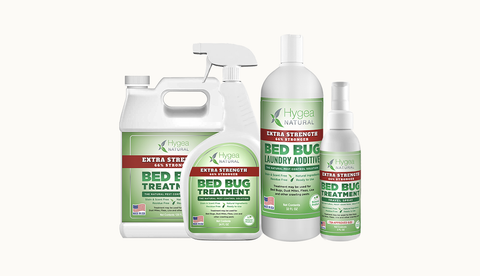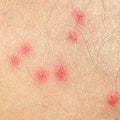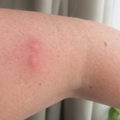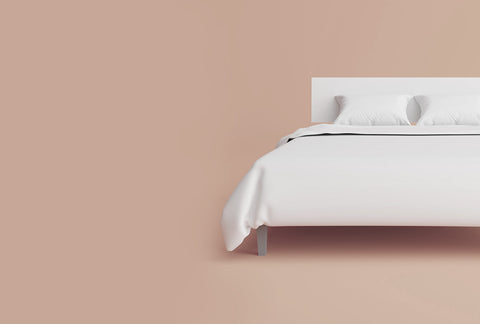NATURALLY AND SAFELY
GET RID OF BED BUGS!
Have you just discovered a bed bug infestation in your home? Don't panic! You can get rid of them without putting your family’s health at risk.
There are natural bed bug treatment products that can help you get rid of these blood-sucking nightmares quickly and safely.
But first, you need to understand a bit about bed bugs and how they spread. You must take a comprehensive approach to protect yourself from bed bugs at all stages of life.
BED BUGS CAN HIDE ALMOST ANYWHERE. MAKE SURE YOU GET RID OF THEM ALL!
Bed bugs are so small, they can be hard to spot. You can be living among them right now and not even realize it. They could be hiding in your mattress, your floorboards, or even your electrical outlets right now and you would never know they were there.
Don’t use bed bug spray and pray they go away. You need a comprehensive solution to make sure you get rid of them for good.
We developed our simple 3-Step Bed Bug Treatment to help you stop bed bugs in their tracks.
Exterminators use it every day to treat homes for bed bugs without harsh pesticides that don’t do the job. Now you can put it to use for yourself with our Total Bed Bug Protection Kit.
Our comprehensive 3-Step Process covers everything you need to know before, during, and after you discover bed bugs in your home. From preparation to prevention, stay proactive against bed bugs and make sure your pest control treatment is a success.
SAVE YOURSELF TIME, MONEY, AND STRESS. LEARN HOW TO GET RID OF BED BUGS AND MAKE SURE THEY STAY AWAY.
We provide you detailed information on our 3-Step Bed Bug Treatment with every purchase.
WHAT TO DO IF YOU HAVE BED BUGS
If you have bed bugs in your home, you need to act fast! You need to get rid of them quickly, before the infestation gets out of hand. If you wait too long, you could end up with hundreds of bed bugs in every inch of your home.
At that point, only a pest control professional can help you. But even if an exterminator comes, you still need to do everything you can to stop them from spreading–or worse, COMING BACK!
When you make bed bug treatment part of your regular routine, it’s not only easier to deal with infestations. You also lessen your chances of having one in the first place.
But bringing toxic chemicals into your home isn’t sustainable.
You can’t expose your family and pets to harmful products just to live a pest-free life.
That’s why we developed a natural bed bug spray that gets to work on contact. It’s 100% effective against bed bugs, dust mites, and other crawling pests.
HOW TO KNOW IF YOU HAVE BED BUGS
Don’t wait until you’re waking up covered in bed bug bites to find out whether you have bed bugs or not. Just answer a few quick questions to see if our bed bug kit can help you.
- Have you noticed a musty odor in your bedroom? Particularly coming from your mattress?
- Have you noticed any dark spots on your sheets, pillowcases, furniture, or clothing lately?
- Have you recently traveled or stayed in a hotel? Or have you recently used public transportation (bus, taxi, train, etc.)?
- Do you live in a city that’s prone to bed bugs? Or have your neighbors gotten bed bugs recently?
- Do you wake up with red, itchy bumps in a straight line or zig-zag pattern? Are you often itchy at night?
If you’ve answered yes to any of these questions, it may be time to do a bed bug treatment in your home. With our natural bed bug solutions, you can inspect your home for bed bugs and take measures to get rid of them at the same time.
WHAT DOES A BED BUG BITE LOOK LIKE?
Bed bug bites usually appear as small, red welts on your skin. Since these pests like to feed in easily accessible places on your body, they will usually revisit the same area more than once. Because of this, the bites will either form clusters or straight lines.
Checking your skin for bed bug bites can tell you whether or not you have an infestation right away. But oftentimes, people confuse bed bug bites with other insect bites.
The impact of this is twofold:
1. You may incorrectly assume you have bed bugs and send yourself into a frenzy.
2. You may incorrectly assume you DO NOT have bed bugs and end up with a huge infestation
If you disregard those bites on your skin for something else, you can end up living with bed bugs for weeks, or even months, until you realize they are there. By then, there could be thousands of them swarming your house. Do not let that happen.
Once you know the difference between what a bed bug looks like compared to other bites, it is a little easier to tell which is which. But keep in mind, not even a doctor can determine whether or not you have bed bugs with 100% certainty. If you suspect you have an infestation, you need to inspect your home for bed bugs at once.
HOW TO INSPECT YOUR HOME FOR BED BUGS
- Look for physical signs of bed bugs: Start by looking for physical signs of bed bugs, such as small reddish-brown insects, shed skins, fecal spots (dark, rust-colored spots), and blood stains on your bedding.
- Check common hiding places: Use a flashlight to inspect bed bug hiding places, including mattress seams, box springs, headboards, bed frames, and bedding. Inspect upholstered furniture, curtains, and carpeting near the bed.
Note:Bed bugs are attracted to the increased levels of carbon dioxide that you breathe out when you are sleeping. They are also drawn by your body heat since they prefer warm places. You are much more likely to find bed bugs hiding in wood and fabrics than you are to find them in cool places like a glass table or a tile floor.” - Inspect your skin for bed bug bites: While not everyone reacts to bed bug bites if you wake up itchy in the middle of the night, it’s a pretty sure sign you may have bed bugs. Look for small, red welts appearing in a cluster or a straight line across your skin.
- Be as thorough as possible: Dismantle your bed and pull back the seams of your mattress. Remove your couch cushions and empty your drawers. Leave no stone unturned. You must identify the source of the infestation before it grows too large.
- Execute a treatment plan: If you find evidence of bed bugs, you must act quickly. Prepare for bed bug extermination immediately to avoid a hostile takeover of your home.
A Single Bed Bug Can Lay Up To 500 Eggs In Its Lifetime…
…and they only take about 2 weeks to reach maturity! That means things can get out of hand quickly if you don’t take action.
1. EGG
Bed bug eggs are tiny, about the size of a pinhead. They are a pale white color and very difficult to detect. Females usually lay eggs in cracks and crevices near where the bed bugs will feed. These places include mattress seams or behind baseboards.
2. NYMPH
After hatching, bed bug nymphs go through four immature stages until they reach adulthood. Nymphs are smaller than adult bed bugs and are usually translucent, making them hard to see. They require a blood meal to molt to the next stage of life.
3. ADULT
Adult bed bugs are about the size of an apple seed, flat, and reddish-brown. They are experts at hiding, and can survive for up to a year without feeding in some conditions.
BUT HOW DO BED BUGS SPREAD? AND WHERE DO THEY COME FROM?
You can bring a bed bug infestation home from almost anywhere. Like your aunt Vivian’s Fourth of July barbecue, or that 5-star rated resort in Aruba.
They spread from person to person by clinging to your clothing, backpack, or luggage.
Then they hitch a ride into your home where they grow in numbers undercover. All the while, they’ve been feeding on your blood!
The best way to get rid of them is in the early stages, before the infestation grows so large that you need to call in professional help. But once you have them, you’ll be losing sleep wondering if they’re really gone for good.
Protect your peace with a bed bug treatment that covers all your bases.
Our Total Bed Bug Protection Kit features natural solutions for getting rid of bed bugs and stopping infestations before they start.
The Bed Bug Total Protection Kit Includes:
24 oz Natural Bed Bug Spray
1 Gallon Bed Bug Spray Refill
32 oz Bed Bug Laundry Additive
Bed Bug-Proof Mattress and Pillow Covers
BED BUG PREVENTION: MATTRESS PROTECTION
It goes without saying that it is much easier to recover from a bed bug infestation in its early stages, when it’s small, than after it has had time to grow out of control. Using a mattress cover is a great way to protect yourself from bed bugs.
When you use a bedbug-proof mattress cover, you shield your bed with an impenetrable surface. It eliminates hiding places that bed bugs can use to get close to you.
Mattress covers will also trap bed bugs that you may have missed during your treatment inside of the encasement. Doing this stops them from biting you while you sleep and they will eventually starve to death.
Using a mattress cover helps prevent the spread of bed bugs at all stages of infestation.
It’s a simple yet effective method of pest control that blends seamlessly into the background.
WHERE ARE BED BUGS HIDING IN YOUR HOME?
There are dozens of bed bug hiding places that you may not even know about. Look out for signs of bed bugs in the following areas:
- Inside your mattress, pillows, box spring, and headboards
- Between your pillowcases, sheets, and bedding
- Inside your clothing, backpack, or purse
- In your closet, dresser, and drawers
- Underneath your couch cushions
- Behind your wallpaper
- Cracks in your floor
- Electrical outlets
- Inside carpet
- and more!
With so many places to hide, it could be a while before you even uncover the infestation. You may be among the unlucky 1 in 3 people who don’t react to bed bug bites at all. By the time you notice the bed bugs, there may be hundreds—or even thousands—hiding in your home!.
By staying proactive against pests, you can stop a bed bug infestation before it is too late.
FOLLOW THESE TIPS WHILE TRAVELING
1. Spray your taxi, airplane seat and luggage. Our spray is odorless and TSA approved, so no worries!
2. When arriving at your hotel, inspect your hotel room. Lift the mattress and inspect the seams, check the headboard and carpet too. If you see any signs of bed bugs, ask for a different room or consider switching hotels.
3. Don’t put your luggage on the floor or bed. Instead, keep it on the luggage rack.
4. Keep your clothing inside the sealed luggage or hang in the closet.
5. When arriving home, don’t bring your luggage in. Put your clothing inside sealed bags until you can wash them. Spray your luggage well and your shoes too (Check your soles to be sure.
If you are not traveling, you can still bring bed bugs into your home from almost anywhere. These sneaky little pests can use anything from clothing to furniture to get into your home.
Never bring furniture or other items you find on the curb into your home, no matter how interesting they seem. You never know what’s waiting for you to let your guard down.
Wash clothing that you buy second-hand immediately. Do not let it sit in your laundry for a week so bed bugs have a chance to escape. Use a bed bug laundry additive.
Steer clear of people or places that may have had a bed bug infestation recently. It can take several weeks, or even months, to confirm that they’re gone for good..
DO CHEMICAL PESTICIDES WORK ON BED BUGS?
Bed bugs have developed resistance to many types of pesticides. This can make control difficult and require the use of stronger chemicals. Plus, bringing those harsh bed bug sprays into your home puts you, your family, and the environment at risk.
Our natural bed bug treatments keep your family safe from harsh chemicals by using enzymes to break down their outer shell. When bed bugs start to develop immunity, you can switch to a stronger formula without risking your health.
It’s also a lot more cost-effective to use natural bed bug treatments that allow you to safely take preventative measures against pests than it is to rely on an exterminator after they’ve taken over your home.
But not all natural bed bug treatments are the same. You need something proven to work!
GET RID OF BED BUGS IN 3 SIMPLE STEPS
To help you get the pest possible results, we provide a 3 step guide with every purchase. It includes detailed instructions on how to make the most of your bed bug treatment, and how to monitor its effectiveness.
If you want to get your bed bug infestation under control, you must follow the guide to ensure that you perform the treatment correctly. It takes proper planning and execution to get rid of bed bugs. Following the guide increases your likelihood of success.
If you have any questions, contact us for assistance.
A NATURAL BED BUG TREATMENT YOU CAN TRUST
WHY HYGEA NATURAL?
We pioneered a family-safe bed bug treatment that’s trusted by professional exterminators.
HOW DOES IT WORK?
Our innovative formula uses natural enzymes to break down the bed bug’s outer shell.
IS IT SAFE?
You can use our non-toxic bed bug treatment products around children and pets stress-free!
IS IT IRRITATING?
This bed bug spray features a stainless, odorless formula with no lingering residual effect.
FAQs
Bed bugs are small, wingless insects that feed on blood to survive. They belong to the family Cimicidae. Bed bugs are typically reddish-brown in color, especially after a blood meal. But they can sometimes be clear. They have flat, oval-shaped bodies about the size of an apple seed.
Bed bugs can come from a variety of sources. They can hide in furniture, clothing, or luggage. You can also bring them home from hotels, movie theaters, and public transportation. Bed bugs typically travel from one place to another by hitchhiking on people’s clothes.
The most common signs of a bed bug infestation are bed bug bites.You may also have bloodstains or fecal stains on your sheets, or mattress, or walls. There is usually a musty odor coming from the part of the room where the bed bugs are hiding.
Getting rid of bed bugs requires a comprehensive approach. It involves a combination of methods. When you follow our 3-Step Bed Bug Guide, you set yourself up for success before, during, and after your at-home bed bug treatment.
There is no evidence that bed bugs carry or spread diseases. But you may experience an allergic reaction to their bites. While not everybody has one, the reaction commonly occurs as itchy red welts on your skin.
Avoid bringing bed bugs home with you. Do not bring anything inside from the curb, and wash all second-hand purchases with a bed bug laundry additive immediately. Use a protective cover for your mattress and box spring, and inspect your hotel rooms when you travel.
No. Bed bugs get their name because they prefer to hide close to their hosts. But they can live in any crack or crevice in your home. This includes your furniture, walls, and even your baseboards. They can travel between rooms or apartments using electrical outlets.
Bed bugs cannot fly. But they can climb. Bed bugs crawl up walls and even drop down from the ceiling onto a person, giving the impression that they fly. Bed bugs can also move exceptionally quickly for their size, making it easier for them to spread from room to room.
In some cases, bed bugs can live up to a year or longer. It depends on the temperature they’re living in, and how much access they have to food. It takes bed bug eggs about 6 to 20 days to hatch. They grow to maturity in approximately 2 weeks.


































